How To Buy A Grill (5 Articles)
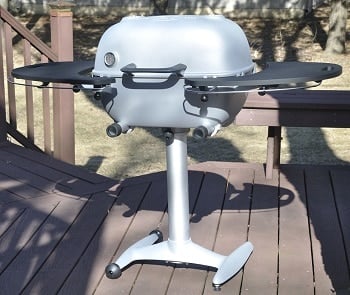
There are too many grills to count. There are small disposable units for picnics, and huge monsters that attach to your tailgate and have as many wheels as a semi.
And boy, they range in price. A nice hibachi that will make great steaks (really) can be had for only $15, and not long ago I saw a stainless steel job in my neighborhood hardware store that said “Financing Available” (really)!
A good grill is an essential tool for the modern cook, not just as a backyard diversion, but as a second oven. It is even important in emergencies. Ask people how they cooked after the hurricane. Try using that line on your spouse.
What a grill does best is create food with a unique flavor, and, because of the high heat, it can come closer to turning out steakhouse steaks better than any indoor oven. Configured properly it can even smoke low and slow as well as a dedicated smoker.
This article is a guide to helping you decide what features you want when shopping for a grill. But there is no single answer to the question “What is the best grill?” because the question lacks two essential words: “for me”. Before you go shopping, ask yourself what you want to cook. Ribs? Steaks? Two very very different cooking processes are needed. Please please do not send me email asking me what you should buy. I don’t know what’s right for you. Read my comments here and on the other pages of the buying guides, and you can figger it out yourself. You can do this.
As background, I strongly recommend you first read these articles:
- Thermodynamics of cooking
- 2-zone and indirect cooking
- Cooking temperatures and the reverse sear
- What fuel is right for you
- Charcoal grills vs. gas grills
- Buyer’s guide to charcoal grills
- Buyer’s guide to gas grills
- Buyer’s guide to tailgate and portable grills
Things to look for when you shop
Size matters. The first decision is size, which relates to price. Start by looking at the number of square inches of primary cooking surface. That’s the main cooking grate. Some manufacturers list total cooking area and that includes the “warming” rack suspended above the primary cooking area. Yes, you can cook up there, but its distance from the flame means food cooks differently up there even though the temp is not a lot lower. A removable warming rack is a nice feature, but the important measurement is the square inches of the main cooking grate.
If the cooking surface is square or rectangular, the formula is easy:

Area = Width times Depth
So if the width is 28″ and the depth is 14″, then
Area = 28 x 14 = 392 square inches
If the cooking surface is round the formula is

Area = pi times the radius squared
Pi is can be rounded to 3.14. The radius is the diameter divided by 2, so measure the diameter across the widest point through the center and divide by 2. To square a number, you multiply it by itself. So the area of a 22.5″ Weber Kettle is calculated like this:
Area = 3.14 x (22.5 … 2) x (22.5 … 2) = 397.4 square inches
When deciding how much surface you need, remember that you do not want to crowd a grill, that you should leave at least 1/2″ between things being cooked. A useful guide is to allow 20.25 square inches for a burger (that’s a 4″ raw burger with 1/2″ space on all sides).
Also remember that the single most important technique you need to learn to up your grilling game is 2-zone and indirect cooking. This is a system where you get one side of the grill hot with the heat source directly beneath the food. The other side of the grill has no direct heat below it, and the heat gets there via convection flow of hot air from the hot side. To do this properly, you should be able to get the food on one half of the surface, so if a chicken cut into parts takes up 12″ x 12″ or 144 square inches (cutting chicken into parts is the best way to grill it and you must leave space around the meat for it to cook properly), then ideal size is 288 square inches for one chicken. If you will be cooking veggies or other sides, then you need more space.
Ask yourself how many people will you normally be cooking for, and don’t forget the July 4 party. You can do some foods in batches, like burgers and dogs, but to do them right, chickens take longer and doing them in batches could be really slow unless you have adequate cooking surface. Allow space for the veggies, too.
Rule of thumb. Allow about 72 square inches total per person, about 9″ x 8″, about the size of a dinner plate.
Price. What is your bottom line? Know what you are willing to spend before going shopping. Just as with a car, the more options, the more expensive. You can get a good charcoal for less than $300. The old reliable, very capable, versatile, and indestructible Weber Kettle can be had for under $100. High end charcoal grills can go for $2,000.
You can get a really nice gas grill for $200 to $400, and be the envy of the neighborhood for $800. Prices can go up to $5,000 for some. But keep in mind, quality does not necessarily increase with price. A lot of the $1,000 units I’ve seen do not out perform some $400 units.
On the other hand, quality will last. I had a Weber Genesis gas grill for 15 years until I gave it to a nephew and he has had it for five years before he gave it away and bought a new grill. It’s probably still out there churning out fine dining. I know someone in my family who buys a new grill every five years because he keeps buying big shiny stainless steel rigs from discount stores, and they fall apart.
Remember to budget for a cover and for thermometers. The dial on most grills is worthless and a good digital probe that can be placed next to the meat can make a huge difference. Manufacturers buy the cheapest model they can find and then mount them up in the dome, a long way away from the food, even higher than the warming rack. If you ever hope to make great meals on a grill, and you can, fit good digital thermometers into your budget. Notice I said thermometers with an s. You also need a good meat thermometer.
Head space. You will want enough room to smoke a turkey, so make sure there is at least 12″ of head space between the cooking grate and the inside of the lid. If there is a warming rack, it should be removable.
Fuel. Fuel. There are now six fuel types to choose from. You need to decide if you want charcoal, gas, logs, wood pellets, or electric. If you like to grill steaks and other red meats, you want to be able to get high heat for searing. You want charcoal or gas. I have a whole article about the strengths and weaknesses of each fuel.
Temperature control. The key to successful cooking is temperature control. If you cannot easily create a 2-zone setup, you are severely handicapped.
Charcoal grills need tight lids and dampers that can be opened or closed to control oxygen to the fire and thus control the heat. Some grills have the ability to raise and lower the coals. This is a nice feature for when you want the coals just below a steak for a solid dark sear.
For gas grills, you want a minimum of two burners so one can be on and one off. But the more the better. With three or four burners you can have hot, medium, and low zones. You also need a lid that closes fairly tight for smoking. Alas, gassers do not seal tightly due to laws to prevent them from building up explosive gases. You also want even heat across the cooking surface. If the burners are too far apart there will he hot and cold spots.
High heat. If you like red meat with a nice dark crust and red to pink inside, even on thin steaks, then you want a grill that can get hot. Charcoal grills can usually do steaks beautifully, especially if you raise the coals to just below the cooking surface. Most gas grills cannot hit that temp unless they have the new infrared or sear burners. If you cook a lot of steaks, and you prefer gas, this is a feature you should consider.
The distance of the heat source from the food can be important. The closer the better for searing, but if gas burners are close to the surface and far apart from each other, you will have hot spots.
Smoking. Can the grill do smoking? If it can, you don’t need a separate dedicated standalone smoker. To smoke properly, you must be able to control airflow. For example, the Weber Kettle charcoal grill does a fine job of smoking because it has excellent airflow control and a tight lid. Add the inexpensive Smokenator and you can compete on the BBQ circuit. Gas grills usually don’t have tight lids in order to allow combustion gases to escape and flamable gas to escape in case of a flameout. You can still smoke on them, you just need more wood.
Burners. On gas grills, aluminum burners corrode and cast iron burners rust. You want stainless steel or brass burners. Stainless 304 is the best grade. If you will only have one grill, try to get one with an infrared or sear burner so you can do steaks properly. Also, pay attention to which way the burners line up, left to right, or front to back. I prefer burners that line up front to back because it is easier to set up multiple heat zones, hot, medium, and low for cooking different foods at once or for indirect cooking. Gas grills usually have a heat diffuser over the burners to protect them from dripping grease and to distribute heat more evenly. Some use metal plates. They can rust and occasionally need replacing. Others use lava rocks or ceramic rocks. They eventually saturate with grease and need replacing.
Starter or igniter. Gas grills need a starter or igniter. Some are electric and need a battery. Others use a button or dial to generate a spark. Crossover ignitions work by lighting one burner first, and the flame crosses over to other burners. Electronic starters are faster, but this is not a deal breaker. There should also be a manual ignition hole so if your igniter breaks you can insert a wood match or stick lighter. Keep long wooden matches on hand in case the ignition fails as it occasionally does.
Materials and durability. The best grills are made from cast iron, powder coated steel, vitreous enamel bonded to steel, cast aluminum, and high quality stainless steel. Heavy steel holds and distributes heat better than thin steel or cast aluminum.
Regular steel and cast iron can rust. Even if painted with a high quality heat resistant paint, this is the least desirable coating since it chips and peels easily.
Powder coating is a thick durable coating that is produced by giving a positive electrostatic charge to a polymer powder, grounding the metal of the grill, spraying it on and bonding it with heat.
Another excellent coating is vitreous enamel. A glass-like powder is sprayed on the metal and melted. It is durable under heat and doesn’t fade, but it is a bit brittle and can crack if you bend or drop it, and rust will form in the cracks. Weber Kettles are enamel coated.
Quality stainless steel and aluminum will not rust, but they do discolor with use and age. Your shiny new stainless grill will never look as good as the day you bought it and trying to make it shine is a waste of good elbow grease.
Workmanship. Does it have sharp edges? Sturdy legs? Wheels large enough to roll over brick, gravel, decking or whatever surface it will live on? Heavy duty hinges and latches? How are the welds? A lot of cheap plastic parts? Will the screws rust? Do the moving parts look like they’ll last? Is the metal thick enough that it will not warp (there is a table explaining the gauge system of measuring steel’s thickness on this page)?
Grates. Most grilling is by radiation or convection, but where the food is in contact with the grates, the cooking is by conduction and that’s how you get dark grill marks. There are a variety of materials used for grates ranging from cheap wire grates, stainless steel, porcelain coated, cast iron, expanded steel, and even extruded aluminum. There is a fanboy cult around cast iron, but I am not a member of the club. Click here to read my article about grill grates and to see which ones I like best. On charcoal grills, some manufacturers offer hinged grates or access doors so you can easily add more coals when necessary. But don’t let crappy grates kill the deal. You can always buy replacement grates. They are not expensive.
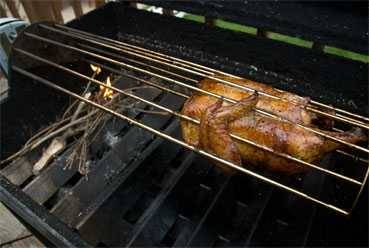
Rotisserie. Rotisserie cooking is an excellent method for cooking whole chickens and turkeys. Most charcoal grills cannot be outfitted with a rotisserie and most gas grills can. You need access to electricity for their electric motors to run. A good rotisserie should have a sturdy motor and a counterweight to balance the load. The best rotisseries are basket types rather than the more common spear that pierces the meat, but they are hard to find. Rotisseries usually cost extra.
Thermometer. Most thermometers on grills are bimetal dials and not accurate. Manufacturers buy the cheapest model they can find and then mount them up in the dome, a long way away from the food, even higher than the warming rack. If you ever hope to make great meals on a grill, and you can and I can help, fit good digital thermometers into your budget. You need one to place on the cooking surface near the meat, and another to check the meat temp. Click this link to read about how thermometers work and see which ones I recommend.
Dual fuel. If you are buying a liquid propane (LP) gas grill, check to see if it can be adapted to household natural gas (NG) and if the adapter kit is included or extra. NG is cheaper, but you need to pay for installation of the pipe and then you can’t roll the grill around. Some new grills have one side for gas and the other for charcoal. This is a great idea since gas is known convenience, temperature control, and easy cleanup, and charcoal for searing heat and smoky flavor. Alas, most of the combos are cheaply built and are compromises on all fronts.
Built-in grills. You might want a grill that can be permanently mounted into an outdoor kitchen. Think carefully about this strategy. When it dies, you will almost certainly be unable to find a replacement that fits into the same slot as the old one. If you decide you want a newer model, or something larger, or you want to switch from gas to charcoal, you’re stuck. There is no standard size for these and it is doubtful the replacement you want will fit. Click here to read more about designing an outdoor kitchen.
Carts and wheels. Many grills come on carts. They should be well built, with sturdy welds and bolts. Some carts are enclosed for storage. You want sturdy shelves and doors. Check to see if they are rainproof. You don’t want your charcoal or pellets getting wet. On really rainy days I roll my gasser right up to the back door so I don’t have to go out. If it has wheels, how sturdy are they? Rubber or plastic? And are they large enough to roll smoothly on a rough surface such a deck, concrete, pavers, or the lawn?
Side shelves. Wooden shelves rot. Are the shelves sturdy? Will they hold a turkey?
Side burners. A side burner is a handy, but not necessary feature. They’re great for making side dishes or warming sauces. A few even have a griddle that sits over them, perfect for eggs, fish, or grilled cheese sandwiches. Most have trouble maintaining a low simmer, so they can burn your sauces. Instead of paying $200 for a built-in side burner, you can buy a standalone burner cheap.
Cover. Does it come with a cover? Most do not. Will the cover last more than a week? Is it so loose fitting it will blow off in the wind?
Assembly. Most grills come knocked down and they can be tricky to assemble. And you will lose a screw. If you don’t have the necessary time or tools, or aren’t confident in your skills, many merchants will assemble for you. For a fee.
Manual. Is there a manual? Was it translated from Chinese by a high school English student?
Cookbook. Some grills come with a nice cookbook. If not, you’ll have to buy my book when it comes out.
Ease of cleaning. Can you remove ash or grease easily? Some charcoal grills have ash collectors, and most gassers have grease collectors. Do the grates come out easily? Can you get at the burners to clean or replace them? Does the grease tray come out easily?
Warranty and support. What kind of warranty and/or guarantee does it come with. On gassers, check the warranty on the burners, sometimes they have a separate warranty than the rest of the grill. You want five to ten years. What is the dealer’s reputation? Is there a phone number and email for tech support or are they hiding? Is the website informative? How about the manual? What if you need parts? How long have they been in business?
Safety. Is it child and pet safe? Are electrical parts safe from rain and snow? Is the grease pan right where the dog likes it?
Footprint. Can it fit in on your condo’s balcony? And speaking of balconies, some buildings have restrictions on they type of grill you can use. Check them out before you whip out that credit card.
Other accessories. Propane fuel gauge? Night lights? Cutting boards? Griddles? Woks? Steamers? Drink holders? Can openers? Surround sound?
Color. I ask my wife what color I want.
Click here to go to our massive database with reviews and ratings of hundreds of grills and smokers
(and remember, we don’t sell anything)
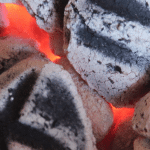
Charcoal Grills Grills: Buying Guide, Reviews, And Ratings
A comprehensive review and buyer's guide of almost all the wood burning and charcoal grills available from experts, with ratings.
What To Look For When Buying Electric Grills
In the market for an electric grill? This comprehensive guide provides you with the tools for selecting the right one, including hands-on reviews and ratings.
What Fuel Is Right For You?
There are six heat sources for cooking outdoors. Each produces a different flavor, and each has its strengths and weaknesses.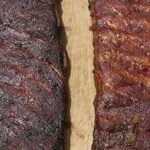
Charcoal Grill vs. Gas Grill Throwdown: Let’s Settle This Once And For All
Meathead settles the argument of Charcoal Grills vs. Gas Grills once and for all.What Fuel Is Right For You?
What To Look For When Buying Electric Grills
Charcoal Grills Grills: Buying Guide, Reviews, And Ratings
Charcoal Grill vs. Gas Grill Throwdown: Let’s Settle This Once And For All
Gas Grills: Buying Guide, Reviews, And Ratings
Published On: 5/13/2019 Last Modified: 2/13/2024

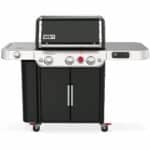

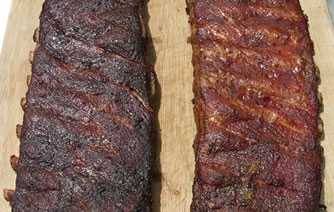
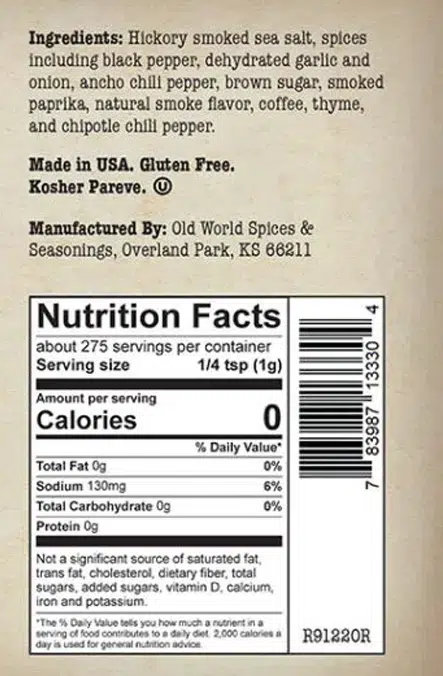



High quality websites are expensive to run. If you help us, we’ll pay you back bigtime with an ad-free experience and a lot of freebies!
Millions come to AmazingRibs.com every month for high quality tested recipes, tips on technique, science, mythbusting, product reviews, and inspiration. But it is expensive to run a website with more than 2,000 pages and we don’t have a big corporate partner to subsidize us.
Our most important source of sustenance is people who join our Pitmaster Club. But please don’t think of it as a donation. Members get MANY great benefits. We block all third-party ads, we give members free ebooks, magazines, interviews, webinars, more recipes, a monthly sweepstakes with prizes worth up to $2,000, discounts on products, and best of all a community of like-minded cooks free of flame wars. Click below to see all the benefits, take a free 30 day trial, and help keep this site alive.
Post comments and questions below
1) Please try the search box at the top of every page before you ask for help.
2) Try to post your question to the appropriate page.
3) Tell us everything we need to know to help such as the type of cooker and thermometer. Dial thermometers are often off by as much as 50°F so if you are not using a good digital thermometer we probably can’t help you with time and temp questions. Please read this article about thermometers.
4) If you are a member of the Pitmaster Club, your comments login is probably different.
5) Posts with links in them may not appear immediately.
Moderators